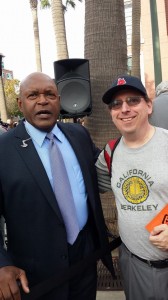The Oakland A’s were often on TV and in the postseason in the 1970s. I would see “Blue, OAK” in the newspaper and hear the name on the radio. At least I thought I heard the name on the radio; I only got it half-right. At the tender age of 6, I voted for “Bida Blue” as a write-in candidate for the All-Star Game, not understanding that the fans couldn’t vote for pitchers. Despite my write-o (sorry, Vida), he started in the 1971 All-Star Game. (He also started the 1978 All-Star Game as a Giant.)
Fast forward to 2002, a point in my life where I had some interesting results in fantasy baseball. I won the CDM Diamond Challenge in Y2K (~9600 entries), participated in the League of Alternative Baseball Reality in 2001, and was trying to start a company that did fantasy baseball gaming (it and I failed miserably). I was invited to participate in MLB.com’s inaugural experts league as a writer for Ron Shandler‘s BaseballHQ.com, and–Lo and behold!–at the draft table, sitting down next to me on my right was Vida Blue.
Vida had a draft partner that day, who told me a bit about his background. He had grown up in Louisiana without much money, was an amazing athlete (football as well as baseball), and didn’t have a fancy education.
For most people, the enduring memories of Vida Blue will be his amazing work as a professional baseball player. For me, it is partly that, but partly what I learned about him that day. Maybe he didn’t have that fancy education, but he had no shortage of intellectual curiosity. To me that’s what counts.
I had done my usual homework to prepare for the event, with a spreadsheet full of baseball data on my laptop. Vida had not seen anything like this and he had all sorts of questions about how to use the laptop to how I got the numbers to how I used the numbers to how I set up a spreadsheet and so on. At the time, most people who saw me using a spreadsheet would have been thoroughly disinterested–either because they had experience with spreadsheets or because they were entirely disinterested in computing. Vida was genuinely interested in understanding something he hadn’t seen before with an enthusiasm that was really fun.
I continue to think that is awesome. Let’s be honest: he didn’t need to be there, he didn’t need the money, he didn’t need to ask any questions of the geeky, nerdy guy. Yet he kept asking questions and seemed really interested. So that’s how I think about Vida Blue.
Vida was also a really nice guy. I really enjoyed that day. (I also enjoyed that league as I won it.) 🙂
Tonight, I saw Vida at AT&T Park, doing work for Comcast SportsNet and, as he was taking pictures with people, I thought, well, maybe he’d remember 2002? He certainly remembered that he participated in a fantasy league that year, but I think any memory of me was long gone. That’s OK; he’s still awesome.
Vida was kind enough to take a picture with me. He still looks like he could win a Cy Young and MVP like he did in 1971.
